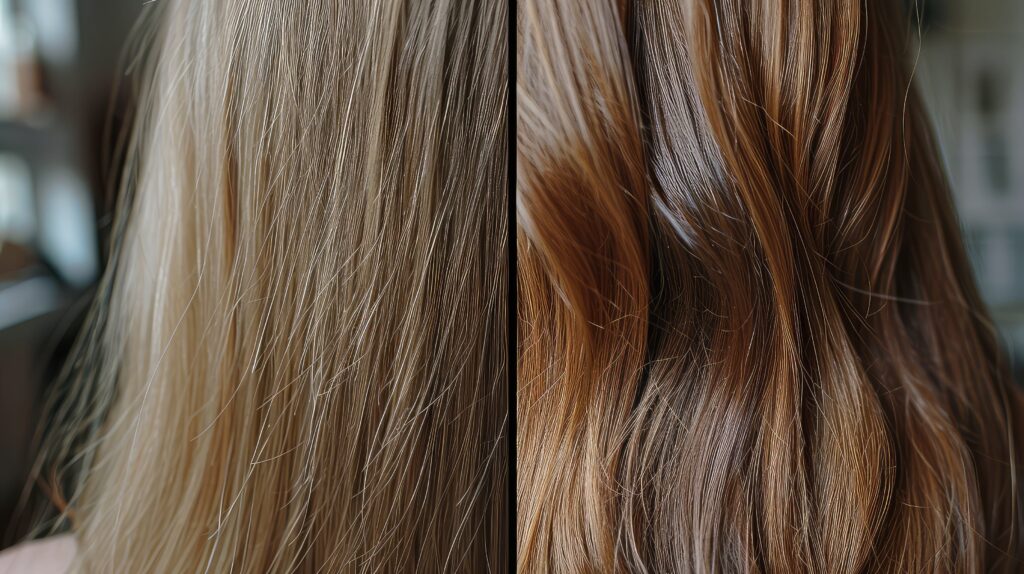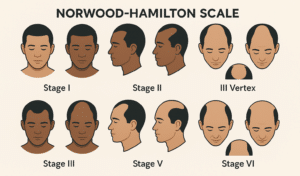Understanding whether you have low vs high porosity hair is essential for a healthy hair care routine. Hair porosity refers to how well your hair can absorb as well as retain moisture. Knowing your hair’s porosity level will help you find the right products and techniques to keep your natural hair looking its best.
This article will explain the differences between low and high porosity hair and guide you on how to identify and care for your specific hair type.
What Is Hair Porosity?
Hair porosity refers to your hair’s ability to absorb as well as retain moisture. It depends on how open or closed your hair cuticles are, the outermost layer of your hair.
If the cuticle layer is tightly packed, it is harder for moisture to penetrate the hair shaft. If it is more open, moisture can enter and leave the hair more easily.
Your porosity level is mostly determined by genetics. However, external factors like heat styling, chemical processing, or product buildup can also affect it. Understanding your hair’s porosity helps you choose the right moisturizing products and techniques for healthy hair care. Many people find that using curly hair products formulated for their porosity level improves hydration and manageability.
How to Test Your Hair Porosity
Testing your hair porosity is simple and can be done at home using a few easy methods.
The Float Test
A common way to test your hair porosity is the glass of water method. Just take a few clean hair strands that have shed naturally and drop them into a glass of room-temperature water. Watch what happens over the next few minutes.
- If the hair floats at the top, you likely have low porosity hair type.
- If your hair sinks to the bottom quickly, then you likely have high porosity hair.
- If it slowly sinks a bit and stays in the middle, you probably have medium porosity hair.
This porosity test is a great first step toward better understanding your hair’s needs.
The Spray Bottle Test
The Spray Bottle Test is another simple way to get an idea of your hair’s porosity level. Start with clean, dry hair. Use a spray bottle to mist a small section of your hair lightly. Then observe what happens to the water droplets on your hair strands.
- If the water droplets sit on top of your hair and don’t get absorbed quickly, your hair likely has low porosity. The tightly closed cuticle layer is repelling the water. If the water absorbs quickly, your hair likely has a high porosity.
- If the water disappears almost immediately into your hair, your hair likely has high porosity. The open cuticle layer allows for rapid absorption.

Characteristics of Low Porosity
Low porosity hair usually has tightly packed cuticles. This makes it hard for moisture to penetrate the hair shaft. As a result, products often sit on the surface and can lead to product buildup.
Signs of low porosity hair include:
- Hair takes a long time to get wet and dry
- Hair feels stiff or straw-like
- A moisturizing product tends to sit on the surface
- Hard for moisture to absorb and retain
Because the cuticle layer is so tight, it helps prevent heat damage but also resists hydration. Using lightweight leave-ins and deep conditioners formulated for low porosity hair can make a significant difference.
Characteristics of High Porosity Hair
High porosity hair has gaps or holes in the cuticle layer. These gaps allow moisture to enter easily, but it also leaves just as fast.
Factors like heat styling and chemical processing can also contribute to increased hair porosity over time.
Signs of high porosity hair include:
- Hair dries very quickly
- Hair is prone to frizz and tangles
- Absorbs moisture fast but struggles to retain it
- Feels rough or dry despite product use
This type of hair can benefit from heavy creams, hair masks, and oils to help seal in moisture. Incorporating protein rich products also helps repair and strengthen the cuticle.
Most Common Low vs High Porosity Hair Types
While hair porosity is not strictly tied to hair type, certain textures may lean towards a particular porosity level.
For example, fine, straight hair often tends to have low porosity because the cuticle layer is naturally smoother and tighter.
Coily and curly hair, on the other hand, is often more prone to having high porosity due to the natural twists and turns in the hair shaft, which can lift the hair cuticles. This explains why many curly hair products are designed specifically for high porosity needs.
Environmental damage, like sun exposure or pollution, can also affect porosity. That’s why your hair porosity types might change over time.
Is Low Better Than High Porosity Hair?
Neither low nor high hair porosity is inherently “better” than the other. Each porosity level has its pros and cons. Low porosity hair is less prone to frizz and damage, but it’s harder for moisture to penetrate the hair shaft. High porosity hair absorbs water fast but loses it just as quickly.
The goal is to understand your hair’s porosity level so you can provide it with the right kind of moisture and care it needs to thrive.
Can I Change My Hair Porosity?
Your natural hair porosity is mostly determined by genetics. However, external factors can change it over time. For example, frequent heat styling without using heat protectants can cause heat damage and make the cuticle layer more open, increasing porosity. Chemically processing your hair with things like perms, relaxers, and bleach can also damage the hair cuticles and lead to higher porosity.
On the other hand, with the right care, you can help restore your hair’s porosity. Steps like avoiding heat damage, protein treatments, using leave-in conditioners, and doing regular deep conditioners or hair masks can help manage porosity.
You may not fully change your natural porosity level, but you can improve your hair’s condition and how it reacts to moisture. It’s about finding the right balance for your hair.

Tips to Care for Your Porosity Type
Low Porosity Hair Tips:
- Use warm water to open the cuticle before applying conditioner
- Apply light, water-based leave-in conditioners
- Avoid heavy oils and butters that sit on the surface
- Using a clarifying shampoo regularly will help to remove product buildup.
- Incorporate shea butter in small amounts for sealing in moisture
High Porosity Hair Tips:
- Use protein treatments to strengthen hair cuticles
- Avoid harsh chemicals and limit heat exposure
- Use heavier products like hair butters and oils to help seal the cuticle layer and prevent moisture loss.
- Layer moisturizing products to lock in hydration
Free Consultation!
Benefit from Dr. Acar’s experience in hair implants to achieve your dream result!
Exploring Hair Restoration Options
If you are dealing with hair loss, no matter your hair’s porosity, you might want to think about a hair transplant in Turkey. Cosmedica is a state-of-the-art hair transplant clinic located in Istanbul, Turkey, and is renowned for its innovative techniques and excellent results.
The clinic is led by Dr. Levent Acar, an English-speaking hair transplant specialist with over 16 years of experience. He is known for creating natural-looking hairlines and uses advanced methods, which promote faster healing and a higher graft survival rate.
You can also view real patient transformations through our hair transplant Turkey before and after gallery. Costs are transparent and affordable; learn more on their Turkey hair transplant cost page.
Conclusion
Understanding your hair’s porosity is essential for keeping it healthy and manageable. Whether you have low, medium, or high porosity hair, knowing how your hair absorbs and retains moisture helps you choose the right hair care products and treatments. It also allows you to avoid damage and improve your overall hair texture and strength. By adjusting your routine based on your porosity level, you can make your hair feel softer, stay hydrated longer, and look its best every day.
For those also considering solutions for hair loss, regardless of their hair’s porosity, Cosmedica in Istanbul, Turkey, offers advanced hair transplant procedures with a focus on natural-looking results.




